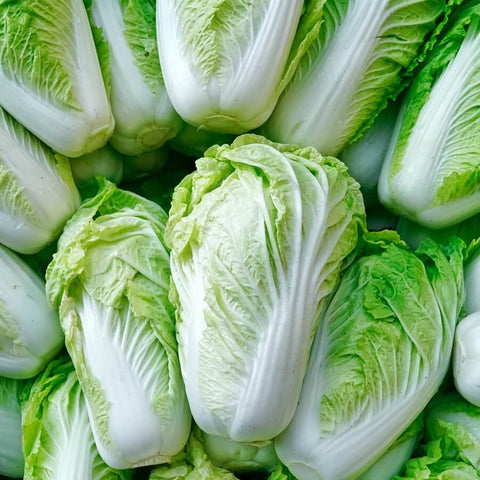

Hortinova
AKENO F1 - Hybrid Napa Cabbage Seeds
Brassica rapa var. pekinensis
- Mid-early maturity: 70 – 75 days.
- Bright green colored heads.
- Heid weight: 1.5 – 2.5 Kg.
- Compact plants of well closed barrel-shapes heads.
- Beautiful yellow internal structure.
- Very strong bolting tolerance.
- High tolerance against many strains of clubroot.
- Hybrid seeds.
- Natural, Untreated, Non-GMO Seeds.
Chinese cabbage may be direct sown or started indoors early for fall and spring crops. For spring planting start seeds indoors about 8 weeks before outdoor planting. Sow 2 seeds per cell, 1/4" deep in cell trays. For summer/fall planting, start seedlings in early summer or direct seed all along summer. For direct seeding, Sow 3–4 seeds every 12–18" (thin to one plant) in rows 18-30". To avoid bolting be sure to wait until the last frost date to transplant or direct-seed the crop.
PLANT OUT: Transplant out in 3–5 weeks taking care not to disturb roots; water-in plants. Plant every 12–18" in rows 18-30" apart. The planting site must have well-draining soil to prevent rot, and it should get at least partial sun. Make sure no nearby taller plants will grow throughout the season and cause too much shade for the cabbage. Container growth is also an option. The more space you give them, the larger the heads will grow.
EXPOSURE: Chinese cabbage can grow in full sun or partial shade. It typically should get at least four to five hours of direct sun each day.
WATER & FEED: Cabbage is a heavy feeder; it quickly depletes the soil of nutrients and needs a steady supply of water and nutrients throughout its growth. Prepare the soil in advance by mixing in aged manure and/or compost. Soil should also be well-draining: roots that stand in water cause heads to split or rot. Water 2 inches per square foot per week. Fertilize 2 weeks after transplanting with a balanced (10-10-10) fertilizer. Three weeks later, add a nitrogen-rich fertilizer; cabbage needs nitrogen in the early stages.
PROTECT: Grow young plants under fleece or mesh to protect against cabbage root fly and flea beetles; root flies will also be deterred using “cabbage collars” — disks that shield the soil at the base of the plant. Create barriers and traps around plants to control slugs and snails. Netting stretched over supports will keep hungry pigeons away. Mulch thickly around the area to retain moisture and regulate soil temperature. Practice crop rotation with cabbages to avoid a buildup of soil-borne diseases.
Chinese cabbage is ready to harvest when the head feels firm. Gently squeeze the head to test it. A mature cabbage head that is ready to be picked will feel dense with little give. Start checking the heads at around 70 days after they've sprouted. To harvest, simply use a knife to cut the head at its base. You also can pull up the entire plant, roots and all, if you wish to clear the planting site. Wrapped in plastic, the head can be stored in the refrigerator for up to two weeks.
Let customers speak for us
from 23 reviewsWe grow several varieties of various colours of tomatoes, and the contrast of these tomatoes with other colours is fantastic. We've had a very long season with our plants, excellent disease resistance, great flavour.

This review applies to all of the seeds I purchased from Hortinova - beautiful tomatoes, good disease resistance and excellent production. Our field season extended to 10 weeks. We've had comments of excellent flavour from our customers as well, highly recommend any Hortinova seed.

This tomato is good taste tomato. Small red round tomato. Bigger then cherry tomatoes but smaller then regular one. I like it. Perfect for salads and fresh eating. Ordered seeds for next season.

2nd time ordering. Very satisfied with qualify and result. Thank you

BALCONY YELLOW F1 - Hybrid Cherry Tomato Seeds

Delivered very fast, packed very good, in professional condition and quality. Thanks

DUETT - Open Pollinated Radish Seeds

We will see what they are like this summer.

Type crimson de bonne grosseur avec une superbe uniformité et très hâtif. Un des premiers prêt en saison. Semences très petites et peu nombreuses. Goût très sucré et chaire croquante. Chair passant du rose au rouge en cours de saison. Les plants sont forts et très vigoureux avec des grosses feuilles.

Vigueur des plants impressionante avec des fruits résistants aux fissures et aux dommages. Très bonne conservartion et goût très sucré lorsque les nervures deviennent orange. Peu être récolté lorsque les nervures sont vertes également. Cavité des semences très compacte et petite laissant beaucoup de chair.

Melon qui fond en boûche avec un goût se rapprochant du melon miel et du cantaloup à la fois, très sucré. Faire attention aux irriguations lorsque le melon devient mature car il peut fendre au champs. Très odorant.

Avec son apparence côtellée, son très gros calibre et ça couleur rose, cette tomate se démarque des autres sur les tablettes. Variété plus résistante à la pourriture apicale que la plus part des autres tomates roses. Bon ensemble de résitance aux maladies également.

Tomate noire dont les faces qui ne sont pas exposé au soleil passent du vert au rouge lorsque mature donnant un aspect unique aux fruits. Charactéristiques similaires à la Barrio avec un goût superbe sans acide. Les clients l'on adoré.

Superbe adaptabilité et excellente résistance aux maladies. Fruits uniformes qui ne fendent pas, bonne conservation. Ajoutez à cela un goût unique avec une légère acidité et une pointe sucré.















